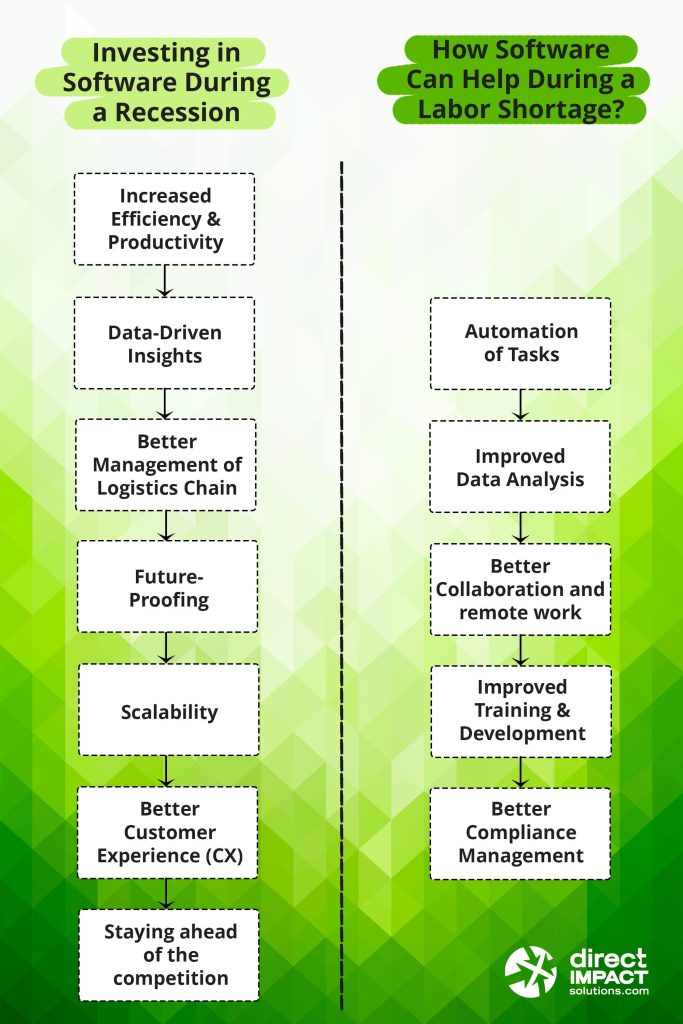
In today’s fast-paced business world, companies are constantly looking for ways to improve their operations and gain a competitive advantage. One of the critical areas they need to focus on is technology.
In a recession, however, many businesses might be hesitant to invest in new software, seeing it as a luxury. This could be a mistake. The right software can increase efficiency, reduce costs, improve the quality of services, enhance products offered, and much more.
Let’s look at how investing in software during an economic downturn can strengthen your company and save you money in the long run.
New Software to Increase Efficiency and Productivity

One of the main benefits of investing in software is the potential for increased efficiency and productivity. Improving data management and streamlining processes means companies can reduce the time and resources required, which translates into lower costs.
Many software options on the market are designed to automate repetitive tasks, freeing up employees’ time to focus on more strategic activities. This can be vital during a recession, when companies may have fewer employees and need to do more with less.
Additionally, many current software platforms offer cloud-based solutions that are more cost-effective than traditional software solutions, and come with lower IT costs. Cloud-based software can offer more flexibility and reliability, better data security, and countless other advantages.
Data-Driven Insights

By leveraging and investing in software, companies can make use of vast amounts of data to gain valuable insights and make informed decisions.
Software can help you collect, organize, track, and analyze data. It can also help streamline your processes, optimize operations, and reduce the risk of errors.
With access to real-time data and insights, leaders can ensure their companies are agile and able to respond to changing market conditions. And along with optimizing your current processes, software can help you identify new opportunities.
That’s an impressive list of advantages. With the proper software, data can be your company’s greatest ally.
Supply Chain and Inventory Management Software

A company’s supply chain is basically its circulatory system. Anything that keeps it from operating properly constitutes a health risk for your organization and should be fixed immediately.
Supply chain management and/or inventory management software is an invaluable tool for companies to manage their logistics chain more effectively. It is especially advantageous during a recession, when businesses need to be more agile and responsive to shifting and unpredictable market conditions.
Providing real-time visibility into the supply chain, these types of software help organizations make informed decisions, minimize disruptions, and reduce costs associated with the logistics chain: inventory management, transportation, production scheduling, order management, and so on.
Supply chain management software is now the norm for nearly every activity related to supply chain management—from vendor management to order tracking to procurement to distribution—and for good reason. If your company hasn’t integrated such software in its processes, don’t wait any longer.
Future-Proofing

Improving your resilience and competitiveness for the short term is part of the equation—but staying ahead of the curve should always be a focus.
Staying up-to-date and acquiring powerful new tools as they enter the tech market can help companies ensure they’re well positioned for future growth, even during a recession. That starts with investing in software: for instance, by taking advantage of new technologies such as AI and machine learning.
Scalability

Software scalability is the ability for a piece of software to shrink or grow according to user needs. This is an important consideration in times of economic turbulence and unpredictability: software that is too rigid may lead to unpleasant costs.
The good news is that most software can be scaled to meet the changing needs of a company, regardless of whether it is in a period of growth or contraction.
Moving operations to the cloud is another good way for companies to scale IT infrastructure without having to invest in hardware and maintenance costs. The flexibility offered by the cloud is an advantage during a slump when companies may need to quickly adjust their operations to shifting market conditions.
Better Customer Experience (CX)

It’s a business staple: investing in software to improve customer experience (CX) is essential for maintaining brand loyalty and attracting new customers.
Today, when individual customer experiences often end up posted as endorsements and criticisms on review websites and social media, ensuring a quality customer experience is more important than ever before.
Add to that the recession factor: this is a moment when retaining existing customers can be crucial to a company’s survival.
Customer experience software can help companies enhance the customer experience by automating customer-facing processes and improving communication.
Staying Ahead of the Competition

It barely needs to be said: technology is transforming the business landscape. Any company that falls behind on investing in software and emerging technologies can quickly become obsolete.

Cutting-edge technologies can help you innovate, stay connected with customers, bolster your value proposition, and differentiate your business from competitors. This can be especially vital during a slowdown when competition is likely to be more intense.
Attracting and retaining top talent is one key to standing out from the competition. Since companies that invest in technology and innovation are often seen as leaders in their industry, this strategy can help them attract and retain top talent, even during a labor shortage.
Software & the Labor Shortage

With fewer employees available, some companies may struggle to meet the demands of their customers. This can lead to missed opportunities and decreased revenue.
However, investing in the right software can help organizations mitigate the impact of a labor shortage and continue to operate effectively.
Automation of Tasks (AI, RPA)

One of the most significant benefits of software during a labor shortage is the ability to automate repetitive and time-consuming tasks. This can help you maintain productivity, even with fewer employees. New software tools are allowing for task automation through the use of AI and RPA (robotic process automation).
Improved Data Analysis & Data Visualization Software

Another benefit of relying on technology while the workforce is downsized is the ability to improve data analysis. The right software can help you collect and analyze data more effectively, enabling you to make more informed decisions and identify areas where you can improve efficiency.
Tools for Better Collaboration and Remote Work

With many employees working from home or in remote locations, software can give companies the tools they need to improve collaboration within and between teams, allowing for better information-sharing and decision-making.
The recent pandemic-driven shift to remote work is likely to experience a new surge during a recession, as companies are compelled to cut costs and reduce their physical footprint. Ensuring a strong and dynamic connection between remote workers and management in this context is key. Project management software can help teams work together more effectively by keeping them up-to-date on project progress so that everyone stays aligned and focused on the same goals.
Software for Training and Development

Another benefit of investing in software during a labor shortage is the ability to improve training and development. With e-learning software, for example, you can provide online training and other development opportunities to employees, regardless of their location.
This can help you upskill and reskill your workforce, even if you have fewer employees, and ensure that they have the support they need to succeed.
Compliance Management Software

Maintaining compliance with regulations and industry standards during a labor shortage can be a challenge. Investing in software specific to an industry can automate compliance management and ensure that you’re meeting all the required standards. This helps avoid costly penalties and ensure that your business is operating effectively and sustainably.
In summary, even when you face the challenges of a recession and a labor shortage, investing in software can be a smart strategy.
Improved efficiency and productivity, more effective data management, enhanced customer experience, better collaboration, reduced costs—the potential advantages are numerous, and clearly tip the scale.
When your company’s success is at stake, cutting good costs along with bad is the wrong move. If you’re considering investing in software for your business, don’t let unfavorable economic conditions hold you back. Acquire the software that will help you thrive even in challenging times.
